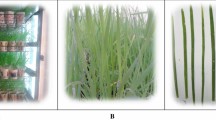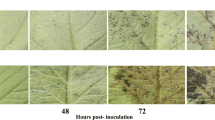Abstract
Assessment of the differential expression of antioxidative enzymes and their isozymes, was done in 30 day-old ex vitro raised plants of three highly resistant (DP-25, Jhankri and Duradim) and one highly susceptible (N-118) genotypes of taro [Colocasia esculenta (L.) Schott]. Antioxidative enzymes were assayed in the ex vitro plants, 7 days after inoculation with the spores (15,000 spores ml−1 water) of Phytophthora colocasiae Raciborski to induce taro leaf blight disease. Uninoculated ex vitro plants in each genotype were used as control. The activity of superoxide dismutase (SOD) and guaiacol peroxidase (GPX) increased under induced blight condition when compared with control. Increase in antioxidative enzymes was more (67–92%) in the resistant genotypes than that (21–29%) of the susceptible genotype. The zymograms of SOD and GPX in the resistant genotypes, with pathogenic infection, showed increased activity for anodal isoform of SOD and increased expression and/or induction of either POX 1 or POX 2 isoforms of GPX. In susceptible genotype, expression of the above isoforms was faint for SOD and nearly absent for GPX under both blight free and induced blight conditions. Induction and/or increased activity of particular isoform of SOD and GPX against infection of Phytophthora colocasiae in the resistant genotypes studied led to the apparent conclusion of linkage of isozyme expression with blight resistance in taro. This might be an important criterion in breeding of taro for Phytophthora leaf blight resistance.
Similar content being viewed by others
Abbreviations
- EDTA:
-
Ethylene diamine tetra acetic acid
- GPX:
-
Guaiacol peroxidase
- NBT:
-
Nitroblue tetrazolium
- PAGE:
-
Polyacrylamide gel electrophoresis
- POX:
-
Peroxidase
- ROS:
-
Reactive oxygen species
- SOD:
-
Superoxide dismutase
- TEMED:
-
N,N,N′,N′-tetramethylethylene-diamine
- TLB:
-
Taro leaf blight
References
Ivancic A. Breeding and Genetics of Taro (Colocasia esculenta (L.) Schott). UNDP, Food and Agriculture Organizations of the United Nations, Ministry of Agriculture and Lands, Solomon Islands, 1992;1–97.
Goenaga R, Singh U, Beinroth FH, Prasad H. SUBSTOR-Aroid: a model in the making. Agrotechnol Transfer 1991;14:1–4.
Ooka JJ. Taro Diseases. Research-Extension-Series, Hawaii Inst Tropic Agricul Human Res 1990;114: 51–59.
Pillai SV, Tkankappan M. Breeding for leaf blight resistance in taro—problems and prospects. J Root Crops 1991; ISRC Nat Sym Special:57–61.
Misra RS. Prevalence and assessment of yield losses of Phytophthora leaf blight of Colocasia in Northern and Eastern parts of India. In: Kurup GT, Palaniswamy MS, Potty VP, Padmaja G, Kabirthumma S, Pillai SV, editors. Tropical tuber crops: problems, prospects and future strategies. New Delhi: Oxford and IBH; 1993. p.␣380–8.
Sahoo MR, Sahu S, Mukherjee A, Naskar SK, Misra RS. In vitro screening of taro genetic resources for tolerance to biotic and abiotic stresses. In: Sahoo S, Ramesh DB, Panda PK, Misra VN, editors. Plant resources utilization. New Delhi: Allied Publishers; 2002. p. 217–23.
Sahoo MR, DasGupta M, Mukherjee A, Sahoo AK, Kole PC. In vitro screening and characterization of taro for Phytophthora leaf blight disease. J Mycopath Res 2005a;43:87–90.
Sahoo MR, DasGupta M, Mukherjee A, Kole P C. In vitro and in␣vivo screening of taro [Colocasia esculenta (L.) Schott] for Phytophthora leaf blight disease. In: Rodrigues BF, Gour HN, Bhat DJ, Kamat, N, editors. Advances in fungal diversity and host-pathogen interaction. Goa: Published by Goa University; 2005b. p.␣144–52.
Bowler C, Fluhr R. The role of calcium and activated oxygens as signals for controlling cross-tolerance. Trends Plant Sci 2005;10:241–6.
Mittler R. Oxidative stress, antioxidants and stress tolerance. Trends Plant Sci 2002; 7:405–10.
Halliwell B, Gutteridge JMC. Oxygen toxicity, oxygen radicals, transition metals and disease. Biochem J 1984;219:1–14.
Mehdy MC, Sharina YK, Sathasivan K, Bays NW. The role of activated oxygen species in plant disease resistance. Physiol Plant 1996;98:365–74.
Neto ADDA, Prisco JT, Filho JE, Abreu CEBD, Filho EG. Effect of salt stress on antioxidative enzymes and lipid peroxidation in leaves and roots of salt-tolerant and salt-sensitive maize genotypes. Environ Exp Bot 2006;56:87–94.
Noctor G, Foyer CH. Ascorbate and glutathione: keeping active oxygen under control. Annu Rev Plant Physiol Plant Mol Biol 1998;49:249–79.
Asada K. Production of active oxygen species in photosynthetic tissue. In: Foyer CH, Mollineaux PM, editors. Causes of photooxidative stress and amelioration of defense systems in plants. Boca Raton: CRC; 1994. p. 77–104.
Gomez JM, Jimenez A, Olmos E, Sevilla F. Location and effects of long-term NaCl stress on superoxide dismutase and ascorbate peroxidase isoenzymes of pea (Pisum sativum cv. Puget) chloroplasts. J Exp Bot 2004;55:119–30.
Rout NP, Shaw BP. Salt tolerance in aquatic macrophytes: possible involvement of the antioxidative enzymes. Plant Sci 2001;160:415–423.
Salin ML. Toxin oxygen species and protective systems of chloroplast. Physiol Plant 1987;72:681–9.
Avrameas S, Guilbert B. Enzyme-immunoassay for the measurement of antigens using peroxidase conjugates. Biochimie 1972;54:837.
Riedle-Bauer M. Role of reactive oxygen species and antioxidant enzymes in systemic virus infection of plants. J Phytopath 2000;148:297–30.
Mckersie BD, Bowley SR, Harjanto E, Leprince O. Water-deficit tolerance and field performance of transgenic alfalfa overexpressing superoxide dismutase. Plant Physiol 1996;111:1177–81.
Retig N. Changes in peroxidase and polyphenol oxidase associated with natural and induced resistance of tomato to Fusarium wilt. Physiol Plant Pathol 1974;4:145–50.
Alcazar MD, Egea C, Espin A, Candela E. Peroxidase isoenzymes in the defense response of Capsicum annum to Phytophthora capsici. Physiol Plant 1995;94:736–42.
Melger JC, Abney TS, Vierling RA. Peroxidase activity in soybeans following inoculation with Phytophthora sojae. Mycopathologia 2006;161:37–42.
Dalisay RF, Kuc JA. Persistence of reduced penetration by Colletotrichum lagenarium into cucumber leaves with induced systemic resistance and its relation to enhanced peroxidase and chitinase activities. Physiol Mol Plant Pathol 1995;47:329–38.
Lee DH, Kim YS, Lee CB. The inductive responses of the antioxidant enzymes by salt stress in rice (Oryza sativa L.). J Plant Physiol 2001;158:737–45.
Parida AK, Das AB, Mohanty P. Defense potentials to NaCl in a mangrove, Bruguiera parviflora: differential changes of isoforms of some antioxidative enzymes. J␣Plant Physiol 2004;161:531–42.
Murashige T, Skoog F. A revised medium for rapid growth and bioassay with tobacco tissue culture. Physiol Plant 1962;15:473–97.
Mukherjee A, Debata BK, Naskar SK. Somatic embryogenesis and chromosomal stability of regenerants in sweet potato and taro. J Sci Industrial Res 1998;57:709–15.
Bradford MM. A rapid and sensitive method for the quantification of microgram quantities of proteins utilizing the principle of protein-dye binding. Annal Biochem 1976;72:248–54.
Giannopolitis CN, Ries SK. Superoxide dismutases. I. Occurrence in higher plants. Plant Physiol 1977;59:309–14.
Urbanek H, Kuzniak-Gebarowska E, Herka K. Elicitation of defense responses in bean leaves by Botrytis cinerea polygalacturonase. Acta Physiol Planta 1991;13:43–50.
Plewa MJ, Smith SR, Wagner ED. Diethyldithiocarbamate suppresses the plant activation of aromatic amines into mutagens by inhibiting tobacco cell peroxidase. Mut Res 1991;247:57–64.
Laemmli UK. Cleavage of structural proteins during the assembly of the head of bacteriophage T4. Nature 1970;227:680–85.
Beauchamp C, Fridovich I. Improved assays and an assay applicable to acrylamide gels. Annal Biochem 1971;44:276–87.
Rao MV, Hale BA, Ormord DP. Amelioration of ozone induced oxidative damage in wheat plants grown under high carbon dioxide: role of antioxidative enzymes. Plant Physiol 1995;109:421–32.
Gomez KA, Gomez AA. Statistical procedures for agricultural research. John Wiley and Sons: New York, USA; 1984.
Rebeiz CA, Montazer-Zouhoor A, Mayasich JM, Tripatthy BC, Wu SM, Rebeiz C. Photodynamic herbicides: recent developments and molecular basis of selectivity. CRC Crit Rev Plant Sci 1988;6:385–36.
Rusterucci C, Stallaert V, Milat ML, Pugin A, Ricci P, Blein JP. Relationship between active oxygen species, lipid peroxidation, necrosis, and phytoalexin production induced by elicitins in Nicotiana. Plant Physiol 1996;111:885–91.
Castillo FJ. Peroxidase and stress. In: Penel C, Gasper T, Greppin H, editors. Plant peroxidases 1980–1990, topics and detailed literature on molecular, biochemical and physiological aspects. Switzerland: University of Geneva Press; 1992. p.187–203.
Moerschbacher MB. Plant peroxidases involvement in response to pathogens. In: Penel C, Gasper T, Greppin H, editors. Plant peroxidases 1980–1990, topics and detailed literature on molecular, biochemical and physiological aspects. Switzerland: University of Geneva Press; 1992. p. 91–99.
Lamb C, Dixon RA. The oxidative burst in plant disease resistance. Annu Rev Plant Physiol Plant Mol Biol 1997;48:251–75.
Hammerschmidt R, Nuckles EM, Kuc J. Association of enhanced peroxidase activity with induced systemic resistance to Colletotrichum lagenarium. Physiol Plant Pathol 1982;20:73–82.
Dutta S, Singh RP, Verma JP. Changes in defense related enzymes in mungbean induced by antagonistic bacteria against bacterial leaf spot pathogen. In: Rodrigues BF, Gour HN, Bhat DJ, Kamat N, editors. Advances in fungal diversity and host-pathogen interactions. Goa: Goa University; 2005. p. 42–57.
Acknowledgements
The first author gratefully acknow- ledges the financial support of ICAR NATP-CGP to carry out the present investigation. The authors are also thankful to the Director, Central Tuber Crops Research Institute, Trivandrum, India and Head, Regional Centre of Central Tuber Crops Research Institute, Bhubaneswar, India for infrastructure facilities.
Author information
Authors and Affiliations
Corresponding author
Rights and permissions
About this article
Cite this article
Sahoo, M.R., DasGupta, M., Kole, P.C. et al. Antioxidative enzymes and isozymes analysis of taro genotypes and their implications in Phytophthora blight disease resistance. Mycopathologia 163, 241–248 (2007). https://doi.org/10.1007/s11046-007-9000-4
Received:
Accepted:
Published:
Issue Date:
DOI: https://doi.org/10.1007/s11046-007-9000-4




